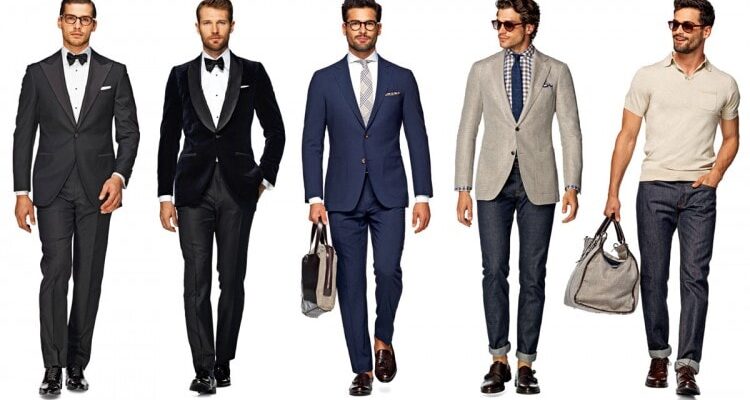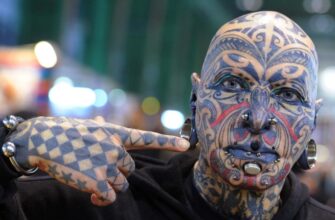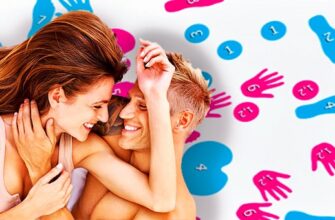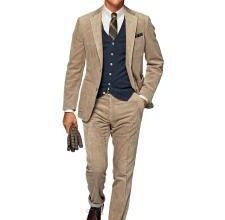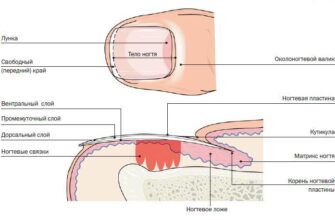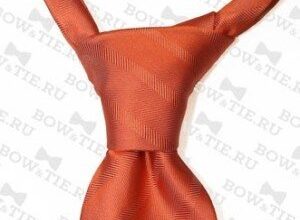Dress code (Dress code) in translation from English – 'Code of clothing'. In a broader sense, a dress code is a set of rules governing what and how to wear for a particular setting, event or event.
Historically, the term 'Dress code' originated in the UK where the dress code for men is very important, especially in royal circles. Initially, it was easy to classify this or that style of clothing, since there were only 4 of them: casual style of clothing (Casual), business (Business), evening (Semi-formal), strict formal (Formal) or the so-called 'Black-Tie' dress -code – a black tailcoat with a black bow tie, which is usually worn in the evening after 6 o'clock and 'White-Tie' – a black tailcoat with a white bow tie, which is accepted to be worn during the day.
Over the years, there has been a large division of the main styles, so every year it becomes more difficult to determine one or another style that is suitable for a particular event or event. In this article we will tell you what a dress code is and what style of clothing is appropriate for a particular event or event.
Making a digression, I want to draw your attention to the fact that in Russian it is customary to write two words separately, separated by a hyphen 'dress code'. Not 'dresscode' or 'drescode'.
Dress code in our life
So, what is the dress code? Where do we meet the dress code in life? Definitely primarily in the workplace. Only when applying for a job, you should already take care of how to dress for an interview. Very often, the office dress code is regulated, even prescribed in regulatory documents when you are applied for a job in a company. The main idea of the dress code is, in fact, to make you more efficient and business-like, so to speak. It is assumed that a person in a formal suit will work more professionally.
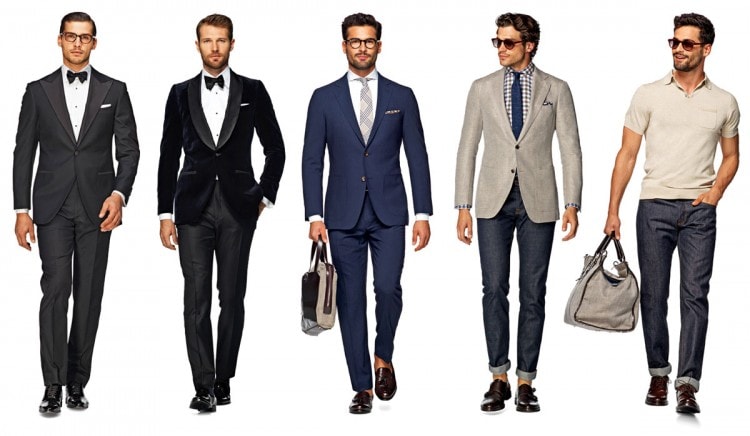 Dress code in our life
Dress code in our life
However, this can be seen in Russia only in large companies that promote the Western model of corporate culture. Most companies adhere only to the principle that it is necessary to wear a formal suit during important events (exhibitions, meetings with a client, etc.), the rest of the time it is allowed to walk less formally, for example, in a T-shirt and jeans.
By the way, employees of restaurants, banks, hotels also adhere to a strict dress code. they always have to deal with clients. They are essentially the 'face' of the company and need to comply with the corporate dress code.
Aside from the office staff, you can find the dress code in schools or universities. Again, such a phenomenon as 'School dress code' is more observed in the West, however, in Russia, it is increasingly common for municipal and private schools to adopt a rule – you need to go to school in school uniform. Even at the level of federal legislation, in my memory, this issue was raised several times. Those who remember the times of the USSR will probably note that uniforms were an obligatory attribute of schoolchildren and schoolgirls.
An example of a holiday or event is a wedding. Who of us was at the wedding or was actually the spouse himself, remember that the dress code is present here as well. The classic dress of the groom is a black classic suit, the bride is a white dress. Guests also try to wear more formal attire. However, in recent years there has been a paradigm shift (beliefs and attitudes) and today there are weddings where jeans and even a swimsuit are appropriate.
Dress code rules can be found in different faiths. For example, in the Orthodox Church there are strict canons regarding the dress of men and women when they visit holy places or events. The canons of Muslim clothing are also strict in relation to believers, women in the first place.
It can take a long time to list examples where the dress code is applied. What is appropriate to wear clothes in a modern city? I will try to classify the dress code for a general idea of the types of dress code.
Types of dress code for men
The classification is based on Western sources. Sadly, they are trendsetters in the past and in the present.
Formal Dress Code for Men – Morning Dress and White-Tie
For reference:
Also called: 'Formal', 'Full formal', 'Full dress', 'Formal attire'.
Varieties: 'White Tie' or 'Morning dress'.
The formal dress code in modern society is somewhat misunderstood. Formal attire is not a classic suit and tie tied in a Windsor knot. This is significantly higher and stricter dress code, which is customary to observe at a limited number of events.
Due to the circumstances that the formal dress code came to us from the UK, the procedure for using the formal dress code is dictated by them.
It is customary to use formal attire for:
- Diplomatic meetings.
- Award Ceremonies.
- Meetings with ambassadors.
- At the Royal Ascot races in the UK.
- Reception with the royal family (of course in Great Britain).
Formal wear is different during the day and evening. During the day, the so-called 'Morning Dress' is required, which features a black tailcoat and vest. In the evening it is customary to wear 'White-Tie', the main feature of which is a white bow tie combined with a white vest and shirt, and the same black tailcoat.
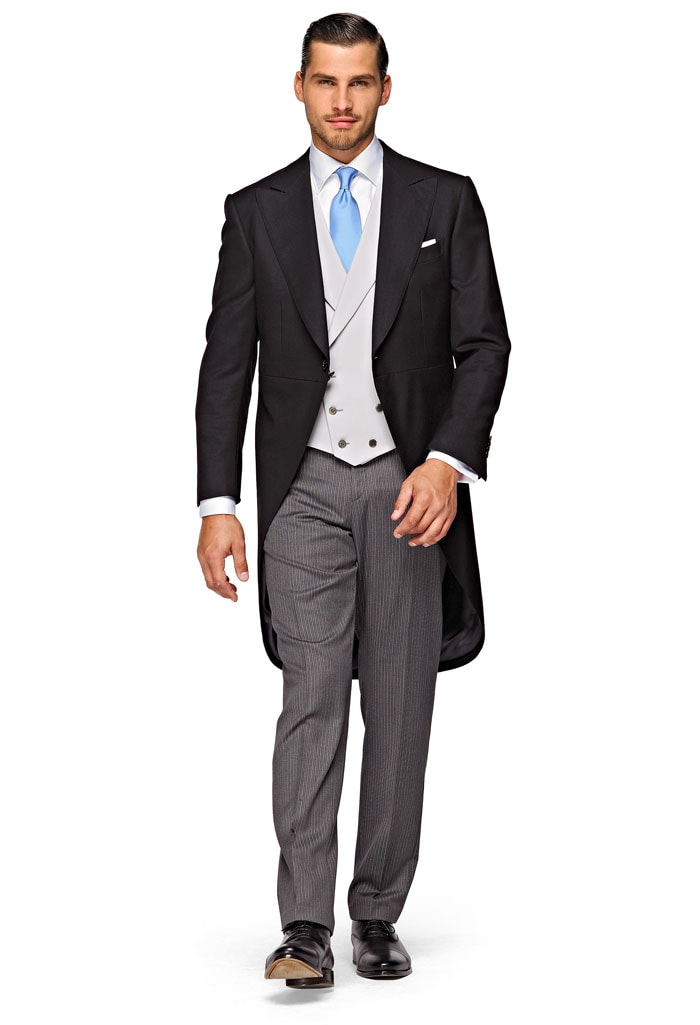 Morning-dress dress code
Morning-dress dress code
Semi-formal dress code for men – Black-Tie and Stroller
For reference:
Also called: 'Semi-formal', 'Smoking', 'Le Smoking'.
Varieties: 'Black Tie' or 'Stroller'.
Note that the 'semi-formal dress code' is still a fairly strict dress code for a man. In ordinary life, such an outfit is not worn.
It is customary to use a semi-formal style of clothing:
- Weddings.
- Solemn awards.
- Charity events.
- Going to the theater.
- Prom.
Similar to the formal dress code, there are also outfits for the day and evening. During the day, it is customary to comply with the 'Stroller' dress code – a somewhat simplified form of 'Morning Dress'. It is appropriate to wear a gray or black tuxedo, gray trousers with white stripes, a gray or silver tie, and a bluish or gray vest. In the evening, it is customary to wear a black tuxedo, black bow tie and white shirt.
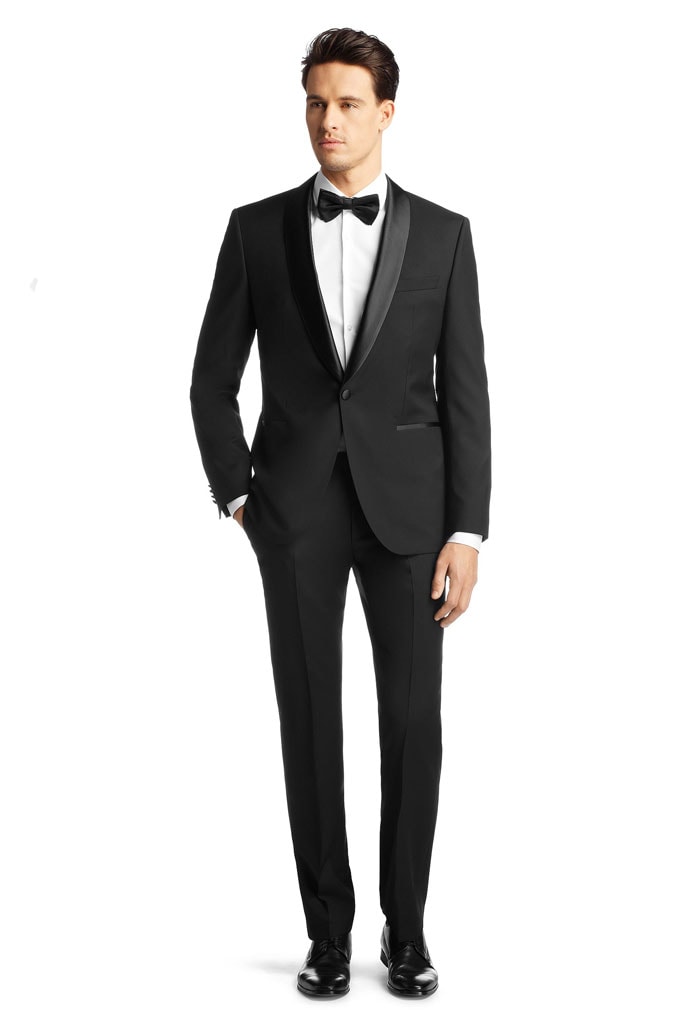 Semi-formal dress code
Semi-formal dress code
Informal Dress Code for Men – Business Dress and Business Attire
For reference:
Also called: 'Informal', 'Cocktail'.
Varieties: 'Business casual', 'Smart casual', 'Corporate Casual', 'Cocktail', etc.
An informal business dress code means one thing – the presence of a classic suit. There is a wide variety of men's suits that are considered more or less formal. For example, a black one-color suit will be considered the strictest, while light-colored striped suits are less strict.
It is customary to use informal clothing on:
- Meetings of business partners.
- Social events.
- Holidays and parties.
- Conferences.
- Walking with friends.
There is no division into daytime and evening time, however, during the daytime, it is preferable to wear light gray or light brown suits. In the evening, it is dark blue or dark gray.
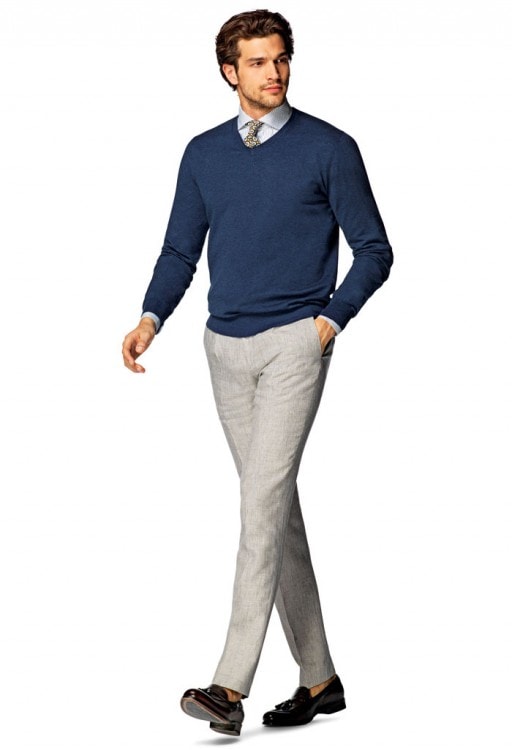 Informal dress code
Informal dress code
Business Casual dress code
As soon as you see the word 'casual' in the name of the dress code, it means that there are many variations of your dress code available. In Business Casual, you no longer need to wear a full suit, just put on trousers, a shirt and jersey. At the same time, you can complement the look with a blazer or a navy blue jacket. Those. the costume can be made up of the details of the classic costume, different in color and pattern.
In any case, if you find yourself at an event where the Business Casual dress code is appropriate (meeting of business partners, meeting friends at a holiday, party, meeting of any conference, etc.), you should put on a tie and bring a sports jacket . You can always remove one or both items and it will be perfectly acceptable.
MEN'S TIES IN OUR ONLINE STORE
GO TO STORE
You should not wear jeans or chinos with a business dress code. Exceptionally classic trousers, maximum white striped trousers. Let's say jersey and sleeveless jackets. The shoes are classic. Read more about Business Casual style.
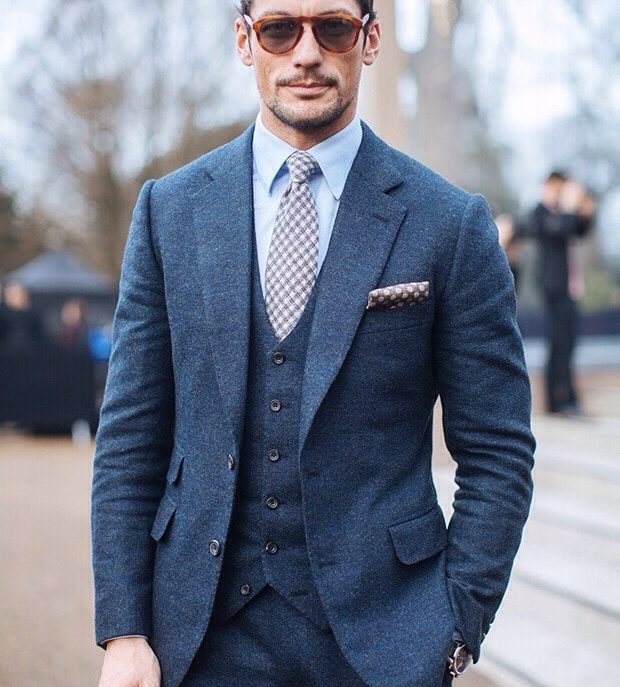 A three-piece suit in dark blue combined with a blue shirt and tie in a burgundy-blue rhombus. Additionally, a burgundy pocket square with blue polka dots is folded.
A three-piece suit in dark blue combined with a blue shirt and tie in a burgundy-blue rhombus. Additionally, a burgundy pocket square with blue polka dots is folded. 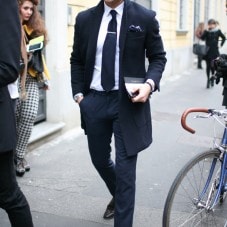 A navy blue coat over a white shirt with a navy tie paired with navy blue pants. Shoes – brown chelsea.
A navy blue coat over a white shirt with a navy tie paired with navy blue pants. Shoes – brown chelsea. 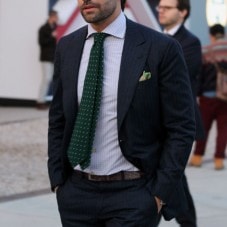 Striped navy suit paired with a striped shirt and green polka dot tie. In addition, a pocket square with a green tint is folded.
Striped navy suit paired with a striped shirt and green polka dot tie. In addition, a pocket square with a green tint is folded. 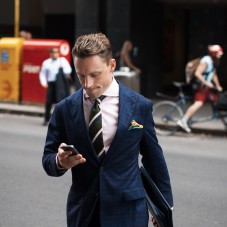 A classic navy check suit paired with a pink shirt, striped pink and green tie and pocket square.
A classic navy check suit paired with a pink shirt, striped pink and green tie and pocket square.
Smart Casual dress code
Smart casual dress code is the freest informal style of clothing. In this outfit, you can still go to a business meeting or party. No tie needed here, but it's still worth grabbing a sports jacket.
Jeans are quite appropriate below, but you should stick to dark blue shades. Shoes should be classic.
Smart casual style assumes an almost everyday environment, but with a bias towards elegance. This is some form of politeness towards people around you. Read more about smart casual style.
 A quilted navy jacket paired with a pink shirt, navy knit tie, gray trousers and brown monks.
A quilted navy jacket paired with a pink shirt, navy knit tie, gray trousers and brown monks. 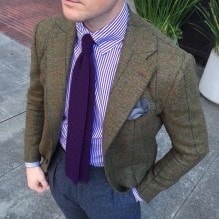 Swamp checkered wool blazer paired with a striped white and purple shirt and a knitted purple tie, pinned to the knot. Bottom – Dark gray wool trousers.
Swamp checkered wool blazer paired with a striped white and purple shirt and a knitted purple tie, pinned to the knot. Bottom – Dark gray wool trousers. 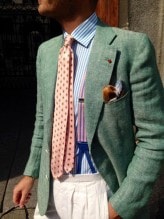 Light green blazer with striped blue and white shirt and silk pink tie. Optional: striped suspenders and a pocket square. Below are beige trousers.
Light green blazer with striped blue and white shirt and silk pink tie. Optional: striped suspenders and a pocket square. Below are beige trousers. 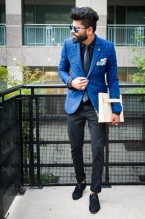 A blue blazer in a black check combined with a black shirt and a dark gray tie. Bottom – chinos paired with suede, navy derby.
A blue blazer in a black check combined with a black shirt and a dark gray tie. Bottom – chinos paired with suede, navy derby.  Light gray double-breasted blazer paired with a white shirt. Bottom – washed blue jeans paired with brown monks.
Light gray double-breasted blazer paired with a white shirt. Bottom – washed blue jeans paired with brown monks. 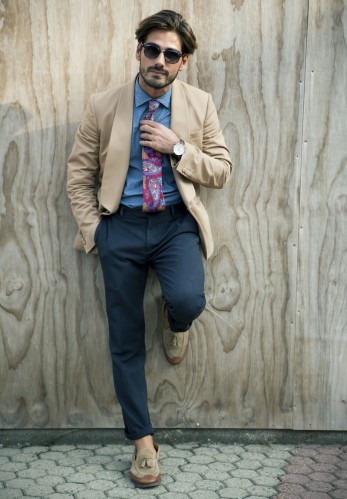 Beige blazer paired with a blue shirt with square prints; burgundy tie with a pattern in the form of cucumbers. Navy blue trousers paired with beige loafers.
Beige blazer paired with a blue shirt with square prints; burgundy tie with a pattern in the form of cucumbers. Navy blue trousers paired with beige loafers.
Casual dress code
The casual dress code allows any liberties in the choice of clothing. As a rule, such clothes are appropriate for a trip to the park or relaxing with friends. Learn more about casual dress code.
Finally
In our country (and on the territory of the CIS, I think too), it is generally accepted to distinguish the following types of dress code:
- formal dress code,
- corporate dress code,
- dress code cocktail,
- smart casual style,
- business casual style,
- casual style.
There are rare cases when a 'Black-Tie' dress code is required, much less a 'White-Tie' dress code, unless some kind of meeting with ambassadors or the presentation of awards. However, among the elite strata of society, more and more often comes the Western trend to dress according to the dress code that is accepted throughout the world. But these are only special cases, not a general trend.

